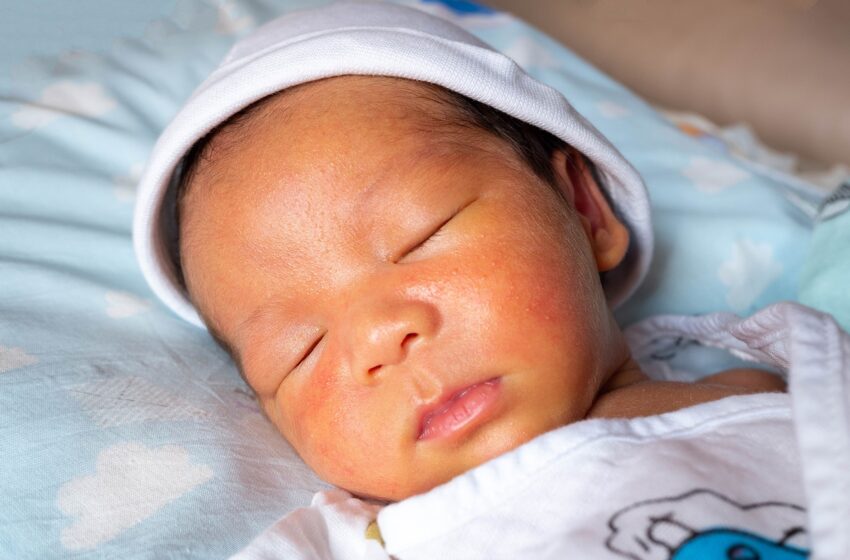What causes high bilirubin in babies?

Every loving couple would want to have a baby of their own. Bearing one’s own child can remind the parents of the mini version of themselves or their childhood. A healthy baby can have a great chance of living better and to have a wonderful moment to be cherished. However, not all babies may be healthy at birth or some babies even get sick days after days of being born. In this DoctorOnCall’s article, we will learn about one of the reasons behind sickness in babies known as high bilirubin.
Bilirubin is the yellowish pigment made from the breakdown of the red blood cells. To remove bilirubin from the body in the stool, the liver breaks down bilirubin. The placenta stops bilirubin from being excreted in a baby’s body as long as it remains inside the mother’s womb. After birth, the baby liver begins to remove this bilirubin but may take some time before it can be effectively removed.
High bilirubin or hyperbilirubinemia, is among the common problems in babies. Common symptom seen in hyperbilirubinemia is jaundice. Jaundice is the yellowing tinge on skin and to the white part of the eyes. It is understandable that high bilirubin can cause great concern in parents but it is not entirely a bad thing. To understand more about this, it is best to know what can cause hyperbilirubinemia. Below are among the common causes for high bilirubin:
- Liver function-immature liver unable to get rid of bilirubin
- Breastfeeding jaundice- babies not consuming enough breast milk in the first few days of life
- Breast milk jaundice- caused by substance in breast milk that interfere the babies liver from processing the bilirubin
- Hemolysis- excessive breakdown of red blood cells that is mediated by immune disorder such as Rh incompatibility and ABO incompatibility or non-immune disorder such as G6PD deficiency or hereditary blood cell disorders (thalassemia or sickle cell disease)
- Infection- commonly from sepsis, rubella and toxoplasmosis
- Thyroid problem- underactive thyroid not producing enough hormone to eliminate bilirubin
- Bile ducts or gallbladder problems- blockage to these structure causes increased of bilirubin
It is estimated that more than half of babies born do get jaundice in the first week of life. Numbers are higher in premature babies. Jaundice that is considered physiological are the one that appears after 24 hours of birth and disappears within 2 weeks. The total bilirubin serum should be less than 15 mg/dL in physiological jaundice. Physiological jaundice is considered normal and should not be worrying. Treatment is typically provided when the total serum bilirubin is higher than what is stated in phototherapy guidelines.
Pathological jaundice is the opposite of physiological jaundice. It is characterised by jaundice that appear within the first 24 hours due to the serum bilirubin level more than 5 mg/dL per day and total bilirubin serum more than 15 mg/dL. The jaundice also persists for more than 2 weeks. It is important to differentiate physiological and pathological jaundice because treatment varies. Furthermore, when jaundice is left untreated, the high bilirubin can cause complications that can be disability or even life-threatening for the babies. Complications include kernicterus (brain damage), cerebral palsy and deafness. Treatment for pathological jaundice depends on the cause identified.
To know high bilirubin, health professionals will run some tests to check for the level of the bilirubin. Most hospitals will check for total bilirubin levels in babies within the first 24 hours using a device known as bilirubinometer. Some healthcare facilities may run blood tests if the bilirubinometer shows high reading. While babies are monitored for signs of high bilirubin in hospital, parents should be aware of the signs too while babies are at home. Signs of high bilirubin are most obvious with jaundice. The best way to check for jaundice at home is to gently press down on the skin where it is close to the bone (such as forehead, nose, chest and shin). Jaundice tends to spread from the face and down to other parts of the body. Rest assured, jaundice on the face alone and upper chest should not be a great concern. In severe cases, babies will show signs of lethargy, fever, vomiting, sleepiness, irritability and difficulty breathing. When babies show signs of severe jaundice and the associated symptoms, the baby needs to get checked by a doctor immediately.
In modern medicine, there are more steps taken by healthcare professionals to ensure they can minimise the problems caused by high bilirubin. Beside using devices to check for bilirubin level in the first 24 to 48 hours of life, healthcare workers will ensure mothers get enough support with feeding and ensure mother’s blood type with antibodies is checked first.
Also read – Dengue Prevention
It can be concluded that there are many causes that could lead to high bilirubin. High bilirubin is most obvious with jaundice as its sign. It is important to understand which jaundice is considered normal or otherwise. Treatment provided will depend on the causes responsible for the high bilirubin.